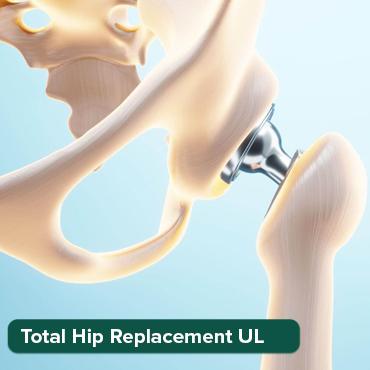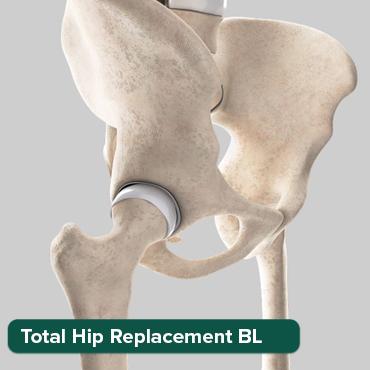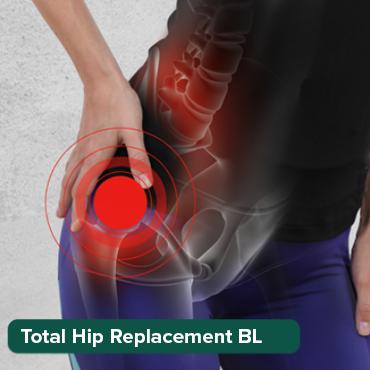
Advanced Robotic Technology Used in Joint Replacement
30 Oct, 2025
 Healthtrip
Healthtrip- Where is Robotic Joint Replacement Performed?
- Why Choose Robotic Joint Replacement Over Traditional Surgery?
- Who are the Ideal Candidates for Robotic Joint Replacement?
- How Does Robotic Joint Replacement Work: A Step-by-Step Guide?
- Examples of Robotic Systems Used in Joint Replacement
- Benefits and Risks of Robotic Joint Replacement
- Hospitals Offering Robotic Joint Replacement
- Conclusion
The Rise of Robotic-Assisted Joint Replacement
Robotic-assisted joint replacement is no longer a futuristic concept; it's a present-day reality transforming orthopedic surgery. Think of it as giving your surgeon the power of a GPS-guided system for your joints! These advanced systems provide surgeons with enhanced visualization, precision, and control during the procedure. Unlike traditional methods, robotic-assisted surgery allows for meticulous planning based on each patient's unique anatomy, using 3D modeling derived from CT scans. This means the surgeon can tailor the implant's size and placement to perfectly match your specific needs. The robot doesn't actually perform the surgery on its own – the surgeon is always in control, guiding the robotic arm and making real-time adjustments. This technology acts as an extension of the surgeon's skill, minimizing human error and maximizing accuracy. Hospitals like Memorial Sisli Hospital in Istanbul are embracing these innovations to offer patients the best possible outcomes. At Healthtrip, we understand the importance of accessing state-of-the-art care, and we're here to connect you with healthcare providers who are at the forefront of this exciting field.
Most popular procedures in India
Benefits of Robotic Joint Replacement
So, what's all the buzz about robotic joint replacement? Let's break down the advantages. First and foremost, we're talking enhanced precision. The robotic arm allows surgeons to make incredibly accurate cuts and implant placements, which can lead to a more natural-feeling joint and improved range of motion. Imagine getting back to your favorite activities with less stiffness and discomfort! Another key benefit is reduced soft tissue damage. The precise movements of the robotic arm minimize disruption to surrounding muscles and ligaments, potentially leading to faster recovery times and less post-operative pain. Who wouldn't want to bounce back quicker? Furthermore, robotic-assisted surgery can lead to smaller incisions, which translates to less scarring and a lower risk of infection. The personalized planning involved also means a more customized fit for your implant, improving long-term stability and reducing the likelihood of future complications. Facilities like Vejthani Hospital in Bangkok offer these innovative procedures, striving to give you the best possible results. Through Healthtrip, we aim to navigate you towards hospitals offering the most advanced options for your specific needs, ensuring you can make the most informed decisions for your health.
Wellness Treatments
Give yourself the time to relax
Lowest Prices Guaranteed!

Lowest Prices Guaranteed!
Types of Robotic Systems Used
The world of robotic-assisted joint replacement isn't a one-size-fits-all scenario. Different systems offer varying functionalities and approaches. Some systems, like the Mako SmartRobotics, use haptic feedback, providing surgeons with tactile guidance during bone preparation and implant placement. Imagine "feeling" the perfect fit! Other systems utilize image-guided technology, creating a real-time 3D map of the joint during surgery, ensuring pinpoint accuracy. Then there are systems that focus on partial joint replacements, targeting only the damaged portion of the joint, preserving healthy tissue and potentially leading to a quicker return to function. The specific type of robotic system used will depend on the surgeon's preference, the patient's individual needs, and the type of joint replacement being performed. Healthtrip is here to help you understand these nuances and connect you with hospitals, such as Fortis Memorial Research Institute in Gurgaon, that specialize in the robotic systems best suited for your condition. We believe in empowering you with knowledge, so you can confidently discuss your options with your surgeon and choose the best path forward.
What to Expect During Robotic Joint Replacement Surgery
Okay, let's talk about what you can expect if you're considering robotic joint replacement. First, you'll undergo a thorough evaluation by your orthopedic surgeon, including imaging tests like X-rays and CT scans. These scans will be used to create a personalized 3D model of your joint, which the surgeon will use to plan the surgery with meticulous detail. On the day of surgery, you'll be given anesthesia, and the surgical team will prepare the area. The surgeon will then use the robotic arm to precisely remove damaged bone and cartilage and position the new implant. Throughout the procedure, the surgeon remains in complete control, guiding the robotic arm and making any necessary adjustments. After surgery, you'll be closely monitored in the recovery room, and a physical therapy program will be prescribed to help you regain strength and mobility. The recovery process is similar to traditional joint replacement, but some patients experience faster healing and less pain with robotic-assisted surgery. Hospitals like Saudi German Hospital in Cairo are equipped to provide comprehensive care throughout the entire process. Healthtrip can facilitate your journey by providing guidance on aftercare, connecting you with rehabilitation specialists and ensuring you have the support you need for a successful recovery.
Is Robotic Joint Replacement Right for You?
Now for the million-dollar question: is robotic joint replacement the right choice for you? That's a decision best made in consultation with your orthopedic surgeon. However, there are some general guidelines to consider. Robotic-assisted surgery may be a good option if you're a candidate for traditional joint replacement and are looking for the potential benefits of increased precision, reduced pain, and faster recovery. It can be particularly beneficial for complex cases or patients with unusual anatomy. However, it's important to remember that robotic surgery is not a guaranteed solution, and individual results may vary. Your surgeon will assess your overall health, the severity of your joint condition, and your individual goals to determine if robotic-assisted surgery is the best fit. Factors like cost and insurance coverage should also be considered. Healthtrip can help you navigate these considerations by providing information on pricing, insurance options, and access to experienced orthopedic specialists at facilities, such as LIV Hospital, Istanbul, who can help you determine the best course of action for your unique needs. We're here to empower you to make informed decisions and embark on your journey to a healthier, more active life.
Where is Robotic Joint Replacement Performed?
Robotic joint replacement, once a futuristic concept, is now a tangible reality offered at an increasing number of hospitals and specialized orthopedic centers worldwide. The adoption of this technology signifies a pivotal shift in surgical precision and patient care, making it accessible to individuals seeking advanced treatment options for joint pain and mobility issues. From bustling metropolitan hubs to burgeoning medical tourism destinations, the availability of robotic joint replacement is expanding, bringing cutting-edge healthcare closer to those who need it most. For instance, in bustling metropolises like Istanbul, Turkey, leading institutions such as LIV Hospital and Hisar Intercontinental Hospital are at the forefront, providing patients with access to state-of-the-art robotic surgical systems. Similarly, in the vibrant city of Bangkok, Thailand, hospitals like Bangkok Hospital and Vejthani Hospital have embraced robotic technology to enhance the precision and outcomes of joint replacement procedures. In Germany, hospitals like Helios Klinikum Erfurt and Helios Klinikum München West are also offering these advanced procedures. Healthtrip can guide you through your options, ensuring you find a facility that aligns perfectly with your needs and preferences, whether you're seeking treatment locally or considering traveling abroad for specialized care.
Beyond these specific examples, many other reputable medical centers are investing in robotic joint replacement technology. In India, hospitals such as Fortis Memorial Research Institute, Gurgaon and Max Healthcare Saket offer robotic-assisted joint replacement surgery. In Spain, you can find this technology at Quironsalud Hospital Murcia and Jiménez Díaz Foundation University Hospital. The United Arab Emirates also boasts hospitals like NMC Specialty Hospital, Abu Dhabi offering these advanced options. It's crucial to remember that the availability of robotic joint replacement can vary even within the same hospital network or geographic region. Therefore, it's always recommended to conduct thorough research and consult with orthopedic surgeons to determine the most suitable treatment approach and the best location for your specific needs. Healthtrip's platform can help you navigate this landscape, providing you with curated information and personalized support to make informed decisions about your joint health.
As robotic joint replacement gains traction, you'll find more hospitals incorporating it into their orthopedic programs. This isn't just about acquiring a fancy piece of equipment; it's about a commitment to providing patients with the best possible care. Hospitals that offer robotic joint replacement often have specialized teams of surgeons, nurses, and technicians who are trained in the nuances of robotic-assisted surgery. They also invest in comprehensive pre-operative planning and post-operative rehabilitation programs to optimize patient outcomes. This holistic approach, combined with the precision of robotic technology, can lead to improved joint function, reduced pain, and a quicker return to an active lifestyle. Healthtrip understands that choosing the right hospital and surgical team is paramount for a successful joint replacement journey. That's why we go beyond simply listing facilities; we provide you with detailed information about each hospital's expertise, technology, and patient satisfaction rates, empowering you to make a truly informed decision.
Why Choose Robotic Joint Replacement Over Traditional Surgery?
The allure of robotic joint replacement lies in its promise of greater precision and accuracy compared to traditional surgical techniques. Think of it as the difference between hand-drawing a circle and using a compass; while both can achieve the desired shape, the compass offers unparalleled accuracy and consistency. In the context of joint replacement, this translates to a surgical procedure where the orthopedic surgeon, guided by a robotic arm, can meticulously plan and execute the implant placement with micron-level precision. This level of accuracy is crucial for achieving optimal joint alignment, stability, and function, ultimately contributing to a more natural-feeling joint and improved long-term outcomes. Traditional joint replacement relies heavily on the surgeon's experience and judgment to estimate angles and alignments, while robotic systems leverage advanced imaging and software to create a personalized surgical plan tailored to each patient's unique anatomy.
Beyond enhanced precision, robotic joint replacement offers several other compelling advantages that may make it a more attractive option for certain individuals. One notable benefit is the potential for smaller incisions, leading to reduced tissue damage, less post-operative pain, and a quicker recovery period. With robotic assistance, surgeons can often perform the procedure through minimally invasive approaches, minimizing the disruption to surrounding muscles and ligaments. This can translate to a shorter hospital stay, reduced reliance on pain medication, and a faster return to daily activities. Furthermore, the enhanced visualization provided by robotic systems allows surgeons to navigate complex anatomical structures with greater confidence, potentially reducing the risk of complications such as nerve damage or blood vessel injury. While traditional surgery is undoubtedly effective, robotic joint replacement offers a compelling alternative for those seeking a more precise, less invasive, and potentially faster recovery experience.
However, it's important to approach the decision of robotic versus traditional joint replacement with a balanced perspective, carefully considering individual needs and circumstances. While robotic surgery offers numerous potential benefits, it's not a one-size-fits-all solution. The suitability of robotic joint replacement depends on various factors, including the patient's overall health, the severity of their joint condition, and the surgeon's experience with robotic technology. It's crucial to have a thorough discussion with an orthopedic surgeon to determine whether robotic joint replacement is the most appropriate option. Also, remember that robotic surgery may come with a higher price tag. Healthtrip can help you compare costs and explore financing options, ensuring that your decision is not only medically sound but also financially feasible. We believe that everyone deserves access to the best possible healthcare, and we're committed to providing you with the resources and support you need to make informed choices about your joint health.
Who are the Ideal Candidates for Robotic Joint Replacement?
Determining whether you're an ideal candidate for robotic joint replacement requires a comprehensive evaluation by a qualified orthopedic surgeon. While the technology offers numerous potential benefits, it's not necessarily the best option for everyone. Generally, individuals who are experiencing significant joint pain and disability due to conditions like osteoarthritis, rheumatoid arthritis, or post-traumatic arthritis may be considered for robotic joint replacement. These are the same conditions that often lead people to consider traditional joint replacement. The decision hinges on the severity of your symptoms and how much they are impacting your daily life. If you are finding it difficult to walk, climb stairs, or perform simple tasks due to joint pain, robotic joint replacement might be a viable option to restore your mobility and improve your quality of life. Beyond the specific diagnosis, your overall health plays a crucial role in determining your suitability for any surgical procedure, including robotic joint replacement.
Individuals with certain anatomical complexities or previous surgeries around the affected joint may particularly benefit from the precision offered by robotic assistance. For instance, if you have significant bone deformities or have undergone prior joint reconstruction procedures, the enhanced visualization and accuracy of robotic surgery can help the surgeon navigate these challenges more effectively. The robotic system allows for more precise implant placement, which is especially critical in complex cases to ensure optimal joint alignment and stability. Similarly, patients with a high body mass index (BMI) may also be considered good candidates for robotic joint replacement, as the technology can help improve surgical precision and reduce the risk of complications in this population. However, it's important to note that these are just general guidelines. Your individual circumstances and medical history will be carefully considered by your orthopedic surgeon to determine the most appropriate treatment approach.
Ultimately, the ideal candidate for robotic joint replacement is someone who is committed to actively participating in their pre- and post-operative care. This includes following the surgeon's instructions meticulously, engaging in a comprehensive rehabilitation program, and making necessary lifestyle modifications to support long-term joint health. Remember, surgery is just one part of the equation; your dedication to recovery is equally important. At Healthtrip, we believe that empowering patients with knowledge is crucial for a successful healthcare journey. We provide you with access to educational resources, support groups, and personalized guidance to help you prepare for surgery, manage your recovery, and achieve your desired outcomes. We also connect you with experienced surgeons who can assess your candidacy for robotic joint replacement and develop a treatment plan tailored to your specific needs.
Also Read:
How Does Robotic Joint Replacement Work: A Step-by-Step Guide?
Robotic joint replacement is like giving your surgeon superpowers! It's not about robots operating independently, but rather a highly skilled surgeon using a robotic arm as an extension of their expertise. Think of it as a GPS system for surgery, providing incredible precision and accuracy. So, how does this futuristic procedure actually unfold, step by step? Let's break it down in a way that's easy to understand and perhaps even a little bit exciting.
First, before you even enter the operating room, the surgeon uses detailed 3D imaging, often a CT scan, to create a personalized surgical plan. This is like having a detailed map before embarking on a journey. The imaging data is fed into the robotic system, allowing the surgeon to visualize your joint in incredible detail. This pre-operative planning is crucial, enabling the surgeon to determine the optimal size and placement of the implant for your unique anatomy. It's like tailoring a suit perfectly to your body, ensuring the best possible fit and function.
Once in the operating room, the robotic arm is prepped and positioned. During the surgery, the surgeon guides the robotic arm, which acts as an extension of their hand. The robotic system provides real-time feedback and guidance, ensuring that the surgeon stays within the pre-defined surgical plan. The robot doesn't perform any actions on its own; it's the surgeon who controls every movement. This enhanced precision allows for more accurate bone cuts and implant placement, which are crucial for joint stability and long-term success. The robotic system acts as a safety net, preventing the surgeon from straying outside the planned parameters. This meticulous approach minimizes damage to surrounding tissues, potentially leading to less pain and a quicker recovery.
After the precise bone preparation, the surgeon carefully inserts the artificial joint components. The accuracy afforded by the robotic system helps ensure that the implant is perfectly aligned and balanced. This is critical for optimal joint function and can help prevent premature wear and tear on the implant. Finally, the surgeon closes the incision, and your journey to a new and improved joint begins! The entire process is a testament to the power of combining human skill with advanced technology, offering the potential for a more precise, less invasive, and ultimately, more successful joint replacement experience. Hospitals like Fortis Escorts Heart Institute, Fortis Shalimar Bagh, Fortis Hospital, Noida, Fortis Memorial Research Institute, Gurgaon and Max Healthcare Saket in India are increasingly offering this advanced technology and you can consult with them and other hospitals like Memorial Bahçelievler Hospital, Memorial Sisli Hospital in Turkey to access the best robotic joint replacement.
Also Read:
Examples of Robotic Systems Used in Joint Replacement
The world of robotic joint replacement is constantly evolving, with new and improved systems emerging regularly. While the fundamental principle remains the same – a surgeon-controlled robotic arm providing enhanced precision – the specific technologies and features vary between different systems. Getting a sense of what's out there can help you understand the options available and have informed conversations with your orthopedic surgeon. Let's explore some examples of robotic systems that are making waves in the field of joint replacement today.
One of the more well-known systems is the Mako SmartRobotics system. This system is designed for hip and knee replacements. It utilizes a tactile robotic arm that provides haptic feedback to the surgeon, allowing them to "feel" the bone as they're preparing the joint. This tactile feedback enhances the surgeon's control and precision, leading to more accurate bone cuts. The Mako system also allows for real-time adjustments to the surgical plan during the procedure, ensuring that the implant is perfectly positioned based on the patient's individual anatomy and joint mechanics. Think of it as having a highly sensitive and responsive tool that adapts to the unique characteristics of your joint.
Another system gaining traction is the ROSA Knee System. ROSA, which stands for Robotic Surgical Assistant, uses a camera and optical trackers attached to the patient's leg to create a 3D model of the knee joint in real-time. This allows the surgeon to visualize the joint from multiple angles and make precise adjustments to the surgical plan during the procedure. The ROSA system also incorporates navigation technology, which helps the surgeon guide the robotic arm with accuracy. This combination of 3D modeling, navigation, and robotic assistance provides the surgeon with a comprehensive tool for performing precise and personalized knee replacements. These Robotic systems are available in hospitals like Vejthani Hospital, Bangkok Hospital and BNH Hospital in Thailand, NMC Specialty Hospital, Al Nahda, Dubai and Thumbay Hospital in Dubai and Saudi German Hospital Alexandria, Saudi German Hospital Cairo, Saudi German Hospital Al-Madinah Almonawara, Saudi German Hospital Dammam, Saudi German Hospital Hail in Saudi Arabia.
It's important to remember that the specific robotic system used will depend on the hospital and the surgeon's preference. Each system has its own unique features and benefits, and your surgeon will be able to recommend the best option for your individual needs. The key takeaway is that these robotic systems are not autonomous robots, but rather advanced tools that enhance the surgeon's skill and precision, leading to potentially improved outcomes for joint replacement patients.
Also Read:
Benefits and Risks of Robotic Joint Replacement
Like any medical procedure, robotic joint replacement comes with its own set of potential benefits and risks. It's crucial to weigh these factors carefully with your surgeon to determine if this approach is right for you. The allure of a more precise and personalized surgery is certainly appealing, but understanding the potential downsides is equally important. So, let's delve into the pros and cons of robotic joint replacement, presented in a clear and balanced way.
One of the primary benefits of robotic joint replacement is the potential for increased accuracy in implant placement. The robotic system allows the surgeon to make more precise bone cuts and position the implant with greater accuracy than traditional manual techniques. This enhanced precision can lead to improved joint stability, better range of motion, and a reduced risk of dislocation. Think of it as building a house with laser-level accuracy, ensuring a solid and stable foundation. Furthermore, the minimally invasive nature of these procedures may contribute to smaller scars, reduced blood loss, and potentially faster recovery times. Many patients experience less post-operative pain and are able to return to their daily activities sooner.
However, it's important to acknowledge the potential risks associated with any surgical procedure, including robotic joint replacement. While rare, complications such as infection, blood clots, nerve damage, and implant loosening can occur. Additionally, there's a learning curve associated with using robotic systems, and the surgeon's experience with the technology can influence the outcome. It's essential to choose a surgeon who is well-trained and experienced in performing robotic joint replacements.
Another factor to consider is the cost. Robotic joint replacement may be more expensive than traditional surgery due to the advanced technology involved. It's important to check with your insurance provider to understand your coverage and out-of-pocket expenses. Discussing these factors with your doctor and insurance provider is vital for making financial decisions. Ultimately, the decision to undergo robotic joint replacement is a personal one that should be made in consultation with your orthopedic surgeon, weighing the potential benefits and risks in the context of your individual circumstances. Hospitals like Mount Elizabeth Hospital and Singapore General Hospital in Singapore, Jiménez Díaz Foundation University Hospital, Hospital Quirónsalud Cáceres and Quironsalud Hospital Murcia in Spain and Cleveland Clinic London, London Medical and The Royal Marsden Private Care, London in the United Kingdom provide the best services and experienced doctors for robotic joint replacement.
Also Read:
Hospitals Offering Robotic Joint Replacement
Finding the right hospital for your robotic joint replacement is a crucial step in ensuring a successful outcome. While Healthtrip can assist you in finding the best options, it's important to have a general understanding of the types of hospitals that offer this advanced procedure. Not all hospitals have invested in robotic technology, and those that have may specialize in different types of joint replacements. So, let's explore some of the factors to consider when searching for a hospital that offers robotic joint replacement.
Generally, large academic medical centers and specialized orthopedic hospitals are more likely to offer robotic joint replacement. These institutions often have the resources to invest in the latest technology and attract surgeons with expertise in robotic techniques. Additionally, hospitals with a strong focus on research and innovation are more likely to be at the forefront of offering cutting-edge procedures like robotic joint replacement. Fortis Escorts Heart Institute, Fortis Shalimar Bagh, Fortis Hospital, Noida, Fortis Memorial Research Institute, Gurgaon and Max Healthcare Saket in India fall into this category. Also hospitals like Memorial Bahçelievler Hospital, Memorial Sisli Hospital in Turkey are also good options. These hospitals generally have an orthopedic department dedicated to robotic surgery.
When researching hospitals, look for those that have a dedicated robotic surgery program and a team of orthopedic surgeons with extensive experience in performing robotic joint replacements. Check the hospital's website for information on their robotic surgery program, including the types of robotic systems they use and the number of robotic joint replacements they perform each year. You can also ask your primary care physician for recommendations or referrals. Hospitals like Vejthani Hospital, Bangkok Hospital and BNH Hospital in Thailand hospitals and NMC Specialty Hospital, Al Nahda, Dubai and Thumbay Hospital in Dubai also have some of the best orthopedic surgeons with experience in robotic joint replacements.
It's also important to consider the hospital's overall reputation and quality of care. Look for hospitals that have received high ratings from independent organizations and that have a strong track record of patient satisfaction. Finally, don't hesitate to contact the hospitals directly and ask questions about their robotic joint replacement program, the surgeons' experience, and the cost of the procedure. Some hospitals such as Mount Elizabeth Hospital and Singapore General Hospital in Singapore, Jiménez Díaz Foundation University Hospital, Hospital Quirónsalud Cáceres and Quironsalud Hospital Murcia in Spain and Cleveland Clinic London, London Medical and The Royal Marsden Private Care, London in the United Kingdom have dedicated staff for international patients and you can consult with them and other hospitals to get the best robotic joint replacement.
Conclusion
Robotic joint replacement represents a significant advancement in orthopedic surgery, offering the potential for increased precision, improved outcomes, and faster recovery times. While it's not a magic bullet and comes with its own set of considerations, the technology holds tremendous promise for patients seeking relief from joint pain and improved mobility. By understanding how robotic joint replacement works, its potential benefits and risks, and the factors to consider when choosing a hospital and surgeon, you can make informed decisions about your treatment options.
Remember, the key to a successful joint replacement, whether robotic or traditional, lies in a collaborative relationship with your orthopedic surgeon. Open communication, realistic expectations, and a commitment to following your surgeon's instructions are essential for achieving the best possible outcome. Healthtrip can be your partner in navigating the world of robotic joint replacement, providing you with access to information, resources, and connections to leading hospitals and surgeons around the globe. Whether you're seeking a second opinion, exploring treatment options, or simply gathering information, Healthtrip is here to support you on your journey to a healthier, more active life.
The advancements in medical technology are constantly reshaping healthcare, and robotic joint replacement is a prime example of how innovation can improve patient care. As the technology continues to evolve and become more widely available, it's likely that robotic joint replacement will play an increasingly important role in the treatment of joint pain and arthritis. Stay informed, ask questions, and work closely with your healthcare team to determine if robotic joint replacement is the right choice for you. With the right approach, you can unlock the potential for a more precise, less invasive, and ultimately, more successful joint replacement experience.
Related Blogs

Frequently Asked Questions About Neuro Surgery
Detailed insights into neuro surgery – doctors, hospitals, technology, recovery,

Advanced Robotic Technology Used in Neuro Surgery
Detailed insights into neuro surgery – doctors, hospitals, technology, recovery,

How Healthtrip Supports Foreign Patients for Neuro Surgery in India
Detailed insights into neuro surgery – doctors, hospitals, technology, recovery,

Top Medical Packages for Neuro Surgery Offered by Healthtrip
Detailed insights into neuro surgery – doctors, hospitals, technology, recovery,

Stepwise Recovery Plan After Neuro Surgery
Detailed insights into neuro surgery – doctors, hospitals, technology, recovery,

Choosing the Right Surgeon for Neuro Surgery
Detailed insights into neuro surgery – doctors, hospitals, technology, recovery,










